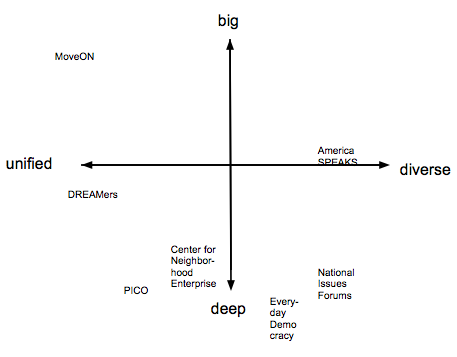- Facebook124
- Total 124
Our important civic organizations can be arrayed from “big” to “deep,” where the big ones touch lots of members, and the deep ones engage relatively small numbers in intensive ways. Meanwhile, the groups can be arrayed from “unified” to “diverse,” where the former organize people who share some common trait–such as an ideology or a social disadvantage–and the latter specialize in convening people who are different from each other. Here are some illustrative examples (with apologies to my friends who are shown below, if you think you should be a placed a little differently).

The top right quadrant (big and diverse) is empty. Charles Tilly said that all social movements needed WUNC: “worthiness,” “unity,” “numbers,” and “commitment.” If your group is demographically or ideologically homogeneous, you can achieve unity along with numbers pretty easily–you just need the mass membership to demonstrate worthiness and commitment. And if your group is small, you can make it unified by bringing everyone into close relationships with each other. But if you want all the people in a diverse nation to engage with each other, that requires numbers, commitment, worthiness, and unity in the face of diversity. The nation-state is supposed to achieve that, but it is not working well. It is no surprise that we lack mass, committed organizations capable of generating unity out of diversity–it is a tall order. But we have done better in the past, and we suffer from the lack today.